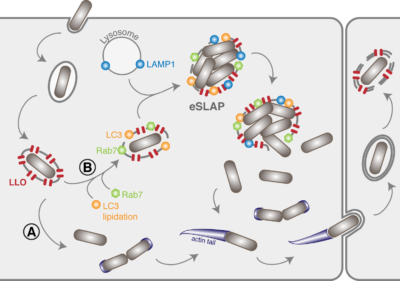Deciphering Listeria invasion pathways? A team led by Prof. Nicolas Desprat and Dr. Alice Lebreton of ENS has just disclosed FAST for monitoring intravacuolar proliferation of Listeria in PLoS Pathogens 2020.

FAST – Listeria life cycle
Real-time imaging of bacterial virulence factor dynamics is critical to understand bacteria colonization strategies. It is however hampered by the limited number of fluorescent tools suitable for tagging secreted effectors.
Here, the authors were able to tag secreted proteins with the fluorogenic reporter FAST. They thereafter implemented it to monitor infection dynamics in epithelial cells exposed to Listeria monocytogenes (Lm). Tracking FAST-labeled vacuoles after Lm internalisation into cells, they unveiled the heterogeneity of residence time inside entry vacuoles. Indeed half of the bacterial population escaped within 13 minutes after entry. However, 12% of bacteria remained entrapped over an hour inside long term vacuoles, and sometimes much longer. And this is regardless of the secretion of the pore-forming toxin listeriolysin O (LLO). They hence imaged LLO-FAST in these long-term vacuoles, and showed as a result that LLO enabled Lm to proliferate inside these compartments. Unexpectedly, Lm proliferated as fast in vacuoles as in host cytosol. Entry vacuoles thus constitute an alternative replication niche in epithelial cells that might promote the colonization of host tissues.
This is already the second paper disclosing FAST in Listeria. Few days ago, Prof. Christophe Beloin of Institut Pasteur and Prof. Nicolas Desprat indeed disclosed FAST for monitoring bacterial protein export in Scientific Reports 2020. Besides Listeria, Lebreton and Beloin and have also reported the use of FAST for bacterial exported proteins, respectively Shigella and E. coli.
The Twinkle Factory distributes commercial fluorogens for FAST and splitFAST.
Stain Different, Tag FAST!
Recent Comments